woodwinds
All scores that include a part for at least one woodwind instrument.
Mozart - Kegelstatt Trio - Alto Flute
 "Kegelstatt" Trio in E-flat major, K.498, by W. A. Mozart
"Kegelstatt" Trio in E-flat major, K.498, by W. A. Mozart
Transcribed for Alto Flute, Viola, and Piano by John W. Pratt, with a Program Note by Peter H. Bloom
Alto Flute Part, PDF $7.99As Editor-in-Chief of Noteworthy Sheet Music, LLC, I recently found myself in the unusual situation of having received transcriptions of the "Kegelstatt" Trio clarinet part for alto flute from two of NSM's most experienced and proficient arrangers, John W. Pratt and Peter H. Bloom. That both arrangers chose to create a "Kegelstatt" part for alto flute, and that their transcriptions were nearly identical, attests to the value of adapting this Mozart clarinet part and its natural fit for the alto flute. Our edition includes Mr. Pratt's alto flute part transcription, as well as a program note written by Mr. Bloom for his upcoming alto flute performances of the "Kegelstatt" Trio with Ensemble Aubade (Peter H. Bloom, flutes; Francis Grimes, viola; and Mary Jane Rupert, piano/harp). —cav, December, 2016
Our edition includes only the alto flute transcription of the clarinet part; the original piano score and viola part are in the public domain and may be downloaded free of charge from IMSLP.org as good quality PDFs.
Preview
Alto Flute part, 6 pages; Total, 10 pages.Schubert - Auf dem Strom - Vo/Cl/Pf
 Auf dem Strom, Op.119, by Franz Schubert
Auf dem Strom, Op.119, by Franz SchubertObbligato transcribed for A-Clarinet by C. A. Vater
Piano Score and Parts for Voice and A-Clarinet, PDF $9.50
The great Austrian composer Franz Peter Schubert (1797-1828) was a master at creating extremely beautiful, melodic, emotional lieder. His song Auf dem Strom (On the River) provided a musical setting for the text of the eponymous poem written by the German poet and music critic Ludwig Rellstab. The lyrics tell the story of a sad parting, of the yearning and loneliness that sets in as the narrator bids farewell to a loved one on shore, while his river journey carries him away towards the sea. The premier performance of Auf dem Strom took place in Schubert’s 1828 public concert, during which the obbligato part was played by Josef Lewy on horn, the instrument for which the obbligato was written and which undoubtedly can provide an appropriately mournful, sentimental character to the piece. However, an alternate obbligato version for cello was also published. Now, with all respect, we provide an A-clarinet version of the obbligato, in expectation that clarinetists will appreciate this addition to the voice/clarinet/piano repertoire. We believe that a well-played clarinet can aptly contribute a suitably complex, dolorous essence and tone that will adequately do justice to this highly romantic lied by Schubert. Schubert himself created one of his most wonderful and popular works, Der Hirt auf dem Felsen, for clarinet obbligato, and we hope he would welcome our adaptation of Auf dem Strom for A-clarinet.
Score, 19 pages; Voice part, 4 pages; A-Clarinet part, 4 pages; Total, 32 pages.
PreviewRobichaux - Recurrence - Flute & Piano
 Recurrence, by Ben Robichaux
Recurrence, by Ben RobichauxContemporary Composition for Flute and Piano
Flute Part and Piano Score, PDF $12.99
NSM welcomed composer Ben Robichaux as a new contributor to our catalog in early June, 2017, when we published his piece Recurrence for flute and piano. For details of Mr. Robichaux's background, interests, and other works, please click the link to access the Composers section of the NSM website.
Recurrence was written for the composer's friend Michael Lyons. As outlined in the program notes, the "duet is framed in a traditional rondo form: ABACA. The returns of the A theme are never literal returns and repeated materials among the differing sections are never identical repetitions. These returns of A are the inspiration for the title, and the re-occurrence of the A material is a study on the lengths that a theme can be stretched and still be recognizable. The returns undergo extensive development. The B and C sections are meant to be extreme contrasts to the A sections as a means of cleansing the aural palate in order to erase the listener's memory of the theme. Despite the great lengths taken to blur the primary theme, its recognizability is undeniable. The closing section is a reflection on the basic differences among the three occurrences of the main theme. This final section is a summation of the processes that have previously been blurred by the contrasting sections of the piece. Ultimately the form portrays a futile fight that concludes with a peaceful resignation to the inevitable."
 The premiere of Recurrence took place in July, 2017, with Kenneth Cox (flute) and Bronwyn Schuman (piano). The performance was recorded by audio engineer Charles Hagaman; a sample can be heard by clicking the mp3 icon.
The premiere of Recurrence took place in July, 2017, with Kenneth Cox (flute) and Bronwyn Schuman (piano). The performance was recorded by audio engineer Charles Hagaman; a sample can be heard by clicking the mp3 icon. The cover artwork for our publication was created by Scoop Brancisco, used with permission.
Piano score, 10 pages; Flute part, 3 pages; Total, 15 pages.
PreviewWeber - Andante e Rondo Ongarese - Alto Saxophone (and Piano)
 Andante e Rondo Ongarese, Op.35, by Carl Maria von Weber
Andante e Rondo Ongarese, Op.35, by Carl Maria von Weber
Transcribed for Alto Saxophone (and Piano) by John W. Pratt
Alto Saxophone Part, PDF $6.99In presenting our transcription of the Andante e Rondo Ongarese by Carl Maria von Weber for alto saxophone, we are keeping with a long-standing tradition of creating saxophone arrangements of 19th century recital pieces. This piece was first written in 1809 for viola, but was revised in 1813 for bassoon, in which form it became increasingly popular. NSM previously published our own version of Weber's Op.35 for clarinet, and after consultation with our saxophonist colleagues we decided to offer an alto saxophone version as well. In preparing his transcriptions of this fun, challenging piece, John Pratt worked from the public domain edition for piano and bassoon at imslp.org, where a free pdf download of the piano part is available. Our edition provides the transcribed solo part, which works perfectly with the pre-existing piano score.
Preview
Alto Saxophone part, 5 pages; Total, 8 pages.Hoffmeister - Sonata in D minor, Op.50, Duo 3 - Two Flutes
 Sonata in D minor, Op.50, Duo 3, by Franz Anton Hoffmeister
Sonata in D minor, Op.50, Duo 3, by Franz Anton HoffmeisterDuet for Two Flutes
Score and Parts, PDF $11.25Franz Anton Hoffmeister (1754-1812) was a German music publisher and prolific composer. He studied law in Vienna, but after becoming captivated by the music scene in that city he devoted the rest of his life to music. His compositional output includes numerous symphonies and overtures, operas, string quartets, pieces for piano, and a great many compositions for flute, including concertos and chamber works. Noteworthy Sheet Music's edition of the Sonata in D minor, Duo 3 from Hoffmeister's Trois Duos pour Deux Flûtes, Op.50 was edited and notated by Richard A. Evans and Bronnie Stroud. Years ago, Mr. Evans located several original editions of 18th and 19th century flute duets, long since out of print, at the Library of Congress. He found them quite enjoyable to play, and undeserving of their current obscurity. NSM agreed and is offering updated editions of these flute-flute duets, as well as editions transcribed for flute and clarinet (browse under under Wind Ensembles or Clarinet).
 Click the mp3 icon to listen to a short audio sample of the Hoffmeister Sonata in D minor first movement, performed and recorded by Demi Stevens, a former student of Richard Evans, playing both parts of the duet.
Click the mp3 icon to listen to a short audio sample of the Hoffmeister Sonata in D minor first movement, performed and recorded by Demi Stevens, a former student of Richard Evans, playing both parts of the duet.
"This is a fabulous duet and has been incredibly fun to practice. Thank you for making it available!"
"Cheers to my mentor's awesome arrangement. I hope you enjoy! With love and admiration, ~Demi"Score, 15 pages; Flute-1 part, 8 pages; Flute-2 part, 8 pages; Total, 34 pages.
PreviewCambini - Sonata in D Major - Two Flutes
 Sonata in D Major, Op.5, No.1, by Giuseppe Maria Cambini
Sonata in D Major, Op.5, No.1, by Giuseppe Maria CambiniDuet for Two Flutes
Score and Parts, PDF $7.99Giuseppe Maria Cambini (1746-1825) was an Italian-born violinist and composer. He was one of the most prolific composers of his era, particularly of instrumental works, of which he wrote over 600, including numerous symphonies, 149 string quartets and over 100 trios, as well as ballets, operas, & oratorios. Flutists will know him for his concertos and extensive body of chamber works featuring the flute, including duos, trios, quartets and quintets.
Noteworthy Sheet Music published this edition of Cambini's Sonata in D Major, Op.5, No.1 at the suggestion of flutist Richard A. Evans, who long ago obtained the duet from the Library of Congress and believed it undeserving of its current obscurity. We at NSM agreed that the duet should be made more readily available to present-day musicians and audiences. Our edition provides both score and parts, and incorporates articulation and dynamic edits supplied by Mr. Evans.
Note that Cambini's Opus 5 flute duets were made into trios by the addition of a bass part composed by Thomas Billington. A PDF scan of the trio edition for two flutes and continuo arranged by Billington is available at IMSLP.org as Cambini's 6 Duos for Two Flutes, Opus 11 (London, printed for Longman & Broderip, n.d.).
Score, 8 pages; Flute-1 part, 4 pages; Flute-2 part 4 pages; Total, 22 pages.
PreviewDevienne - Sonata in D Major - Two Flutes
 Sonata in D Major, Op.10, No.1, by François Devienne
Sonata in D Major, Op.10, No.1, by François DevienneDuet for Two Flutes
Score and Parts, PDF $9.99
François Devienne (1759-1803) was a French composer, flutist and bassoonist, as well as a professor at the Paris Conservatory. His compositional output included: 12 operas; many concerted pieces for various wind instruments, with orchestra; overtures; concertos, quartets, trios, sonatas, etc. for flute, piano, and other instruments; 12 suites; numerous romances, chansons, etc.; and an influential flute method book, Méthode de flûte (1795).
Noteworthy Sheet Music published this edition of Devienne’s Sonata in D Major, Op.10, No.1 at the suggestion of flutist Richard A. Evans, who long ago obtained the duet from the Library of Congress and believed it undeserving of its current obscurity. We at NSM agreed that the duet, which has two movements, Allegro spirituoso and Rondo: Allegro poco presto, should be made more readily available to present-day musicians and audiences. Our edition provides both score and parts, and incorporates articulation and dynamic edits supplied by Mr. Evans.
Score, 10 pages; Flute-1 part, 5 pages; Flute-2 part 5 pages; Total, 24 pages.
PreviewDrouet - Salute to New York - Flute and Piano
 Salute to New York, A Song for the Flute, by Louis Drouet
Salute to New York, A Song for the Flute, by Louis DrouetEdited and with a Foreword by P. H. Bloom
Piano Score and Flute Part, PDF $5.99We have posted Peter H. Bloom's fascinating and highly informative © foreword to this edition, in its entirety, elsewhere on our website, under Resources - Reviews & Articles, so please visit that page for additional historical details regarding the composer, Salute to New York, the New York Crystal Palace, and Hall & Son's flutes, beyond the short excerpts and paraphrases included here.
Louis-Francois-Philippe Drouet (1792-1873) is one of the most highly esteemed flute virtuosi in history. Innumerable contemporary press accounts of his concert triumphs throughout Europe attest to his technical brilliance and exquisite musicianship. He was a prolific and accomplished composer, author, flute theoretician, and pedagogue. His many etudes are still prescribed as tools for flute mastery. His Method of Flute Playing (1830) and 72 Studies on Style and Taste (1855) provide us with useful information concerning instrumental technique and performance practice in the mid-nineteenth century.
The exquisite Salute to New York, A Song for the Flute was performed by Mr. Drouet at the Crystal Palace in New York, on the occasion of its grand reopening under the new management of showman P. T. Barnum in 1854. Our renotated edition of the piece was edited by flutist Peter H. Bloom, who also has enhanced the original piano score with the addition of chord changes in order to broaden the scope of potential players.
Score, 4 pages; Flute part, 2 pages; Total, 14 pages.
PreviewSchubert - Auf dem Strom - Voice/Bass Flute/Pf
 Auf dem Strom, Op.119, by Franz Schubert
Auf dem Strom, Op.119, by Franz SchubertObbligato transcribed for Bass Flute by C. A. Vater
Piano Score and Parts for Voice and Bass Flute, PDF $9.50
Preview
The great Austrian composer Franz Peter Schubert (1797-1828) was a master at creating extremely beautiful, melodic, emotional lieder. His song Auf dem Strom (On the River) provided a musical setting for the text of the eponymous poem written by the German poet and music critic Ludwig Rellstab. The lyrics tell the story of a sad parting, of the yearning and loneliness that sets in as the narrator bids farewell to a loved one on shore, while his river journey carries him away towards the sea. The premier performance of Auf dem Strom took place in Schubert's 1828 public concert, during which the obbligato part was played by Josef Lewy on horn, the instrument for which the obbligato was written and which undoubtedly can provide an appropriately mournful, sentimental character to the piece. However, an alternate obbligato version for cello was also published. Now, with all respect, and at the suggestion of our flutist colleague Peter H. Bloom, we offer a bass flute version of the obbligato. Most of the transposed horn part falls nicely within the sweet range of the bass flute, and very few adaptations were required. Though clearly having different sonic qualities than a horn, the bass flute lends a forlorn, haunting, earthy tone that can well do justice to this Schubert song. After giving the bass flute obbligato a try, Mr. Bloom commented: "Fabulous! // The tone-color of the bass flute for this number is gorgeous."CD - Tea-Time Classics - Flute and Harp
 Tea-Time Classics
Tea-Time Classics
Robin Chudy, harp and Peter H. Bloom, flute
Soundjewel Productions, SJ.240.1, CD $14.97
This sachet of classic and exotic harp and flute music was inspired by the elegant ritual of afternoon tea. It is the ideal accompaniment to tea-time, or any time an infusion of relaxation and euphoria is needed. Previously based in Boston, harpist Robin Chudy played the harp daily for fourteen years at the Ritz-Carlton Hotel, where she developed a style suited to relaxed listening in the Tea Lounge and Cafe, and acquired a broad repertoire of classical and lighter compositions, many her own arrangements. Well-known to our website visitors, Peter H. Bloom is a consummate flutist, NSM editorial consultant, and NSM contributing composer and arranger.Tea-Time Classics
To listen to audio clips of selected tracks, click on the mp3 icons beside the titles.
1. Menuet from l’Arlésienne Suite no. 2, Georges Bizet, 4:12

2. Morceau de Concours, Gabriel Fauré, 2:29
3. Suite of Waltzes from Tales from the Vienna Woods, Johann Strauss, 8:06
5. First Arabesque, Claude Debussy, 4:13
6. Entr’acte from Act III of the opera Carmen (arr: Quinto Maganini), Georges Bizet, 4:17
7. Romanza from Act I of the opera La Wally, Alfredo Catalani, 3:18
8. Sentimental Walk from Diva (Tr: Ed Meredith, arr: R. Chudy), Vladimir Cosma, 3:07
9. Danza Habanera, Th. H. Northrup, 3:04
10. I Dreamt I Dwelt in Marble Halls from The Bohemian Girl, M. W. Balfe, 4:27
11. Theme from Brideshead Revisited, Geoffrey Burgon, 2:44
12. Gnossienne no. 1, Erik Satie, 2:23
13. Gnossienne no. 2, Erik Satie, 1:25
14. Gnossienne no. 3, Erik Satie, 1:59
15. Rêverie, Claude Debussy, 3:30
16. Étude, Opus 10 no. 3 (excerpt), F. Chopin, 2:28
17. The Swan, Camille Saint-Saëns, 2:20To order a copy of theTea-Time Classics CD for $14.97, please use the Noteworthy Sheet Music Contact Us form to let us know which CD(s) you would like to purchase, along with your email contact information and shipping address. For orders shipping to addresses in the USA, a $4.99 shipping and handling fee will be added; for international orders shipping outside the USA, the fee is $14.99. We will send you a PayPal invoice for the sale and, once we receive notice from PayPal that you have paid for the item(s), Americas Musicworks will ship your CD(s) to the address provided, for delivery in 7-10 days.
Hauptmann - Bereavement - Alto Flute & Piano
 Lento - Bereavement, by Moritz Hauptmann
Lento - Bereavement, by Moritz HauptmannTranscribed for Alto Flute and Piano by C. A. Vater
Piano Score and Alto Flute Part, PDF $3.99
Hauptmann's 3 Violin Duos, Op.16 were first published in 1832. The Lento (Bereavement) from Op.16 later was arranged for violin and piano by the renowned violinist, violist, and composer Heinrich Wilhelm Ernst. It is this arrangement by Henri Ernst, published in 1880, that served as the basis for NSM’s transcription of the piece for alto flute and piano. The mournful simplicity of the Lento is perfectly captured and beautifully rendered by the alto flute.Alto Flute part, 1 page; Piano Score, 2 pages; Total, 6 pages.
PreviewElgar - Chanson de Matin - Fl & Pf
 Chanson de Matin, Op.15, No.2, by Edward Elgar
Chanson de Matin, Op.15, No.2, by Edward ElgarTranscribed for Flute and Piano by C.A.Vater
Flute Part and Piano Score, PDF $6.99
Edward Elgar composed his Chanson de Matin for violin and piano c.1889-1890. The two companion pieces, Chanson de Matin (No. 2) and Chanson de Nuit (No. 1), together constitute his Op.15, and both pieces were later arranged for small orchestra by the composer. Chanson de Matin was received with great enthusiasm, and its initial and lasting popularity can be attributed largely to its strong melodic appeal. Enduring public affection for the piece has spawned the creation of numerous arrangements and transcriptions, including renditions for cello and piano, viola and piano, flute and guitar, piano solo, organ solo, and string quartet. Noteworthy Sheet Music offers two of our own transcriptions of the lovely Chanson de Matin, one for alto flute and piano and one for concert flute and piano.
Flute part, 2 pages; Piano Score, 4 pages; Total, 12 pages.
PreviewSchubert - Rondo in B minor - Flute (and Piano)
 Rondo in B minor, D.895, by Franz Schubert
Rondo in B minor, D.895, by Franz SchubertTranscribed for Flute (and Piano) by J.W.Pratt and C.A.Vater
Flute Part, PDF $11.99
The Rondo in B minor, D.895 (alternatively known as Rondeau brillant) was written for violin and piano in 1826 by the great Austrian composer Franz Peter Schubert. Dedicated to the young violin virtuoso Josef Slawjk, the Rondo is demanding in both the solo and piano parts. The work consists of an Andante introduction and an Allegro rondo, and is quite long at 713 measures and typically some thirteen minutes or more in duration. Inexplicably, the piece is less familiar to players and audiences than many of Schubert’s other works. Brian Newbould, renowned composer, conductor, author, and Schubert expert, wrote of the Rondo in his treatise Schubert: The Music and the Man (University of California Press, Jan 1, 1997, p365): “Not surprisingly, perhaps, it is little known because it is seldom played. But it is also undervalued: it scintillates, dances and sings, with a blend of infectious joy, tireless energy, rhythmic zip and ‒ from time to time ‒ heart-melting turns of melody and harmony.”
These characteristics and the way the music realizes them are not only suitable to but often even suggestive of a wind instrument. Our transcription provides effective flute-friendly alternatives for the violin’s double-stops as well as for notes that fall below the flute’s range, so the piece can be played comfortably and beautifully on flute. The Rondo is virtuosic in places, showy and exciting, and overall great fun to play. The Noteworthy Sheet Music edition of our transcribed flute part does not include a re-notated copy of the score, since high-quality PDFs of the piano and violin score are freely available in the public domain and are sufficient to use along with our flute part, in lieu of violin. To download one such PDF of the score, please visit the Rondo’s page on IMSLP.Flute part, 12 pages; Total 14 pages.
PreviewPopp - Greetings to Hungary - Flute and Piano
 Greetings to Hungary, Op.407, by Wilhelm Popp
Greetings to Hungary, Op.407, by Wilhelm PoppFlute and Piano
Flute Part and Piano Score, PDF $0.00
Wilhelm Albrecht Otto Popp (1828-1903) was an esteemed German composer, flutist, and pianist. He received his flute training from Caspar Kummer and Louis Drouet, and served as court pianist and flutist at the Ducal Saxon Court Theater in Coburg-Gotha. In 1867 he moved to Hamburg and became first flute of the Hamburg Philharmonic Orchestra. Popp composed some 600 works, many of which were written for flute and piano; most of his compositions were published in his lifetime and were well-known to musicians of his day.
Wilhelm Popp’s Gruß an Ungarn (Greetings to Hungary) was first published for flute and orchestra in 1890, and an edition for flute and piano was published in 1899. NSM re-notated the flute and piano version, changing only the formatting and adding bar numbers and a new cover page. With a decidedly Hungarian sentiment, this piece is great fun to play and provides an enjoyable, exciting listen for audiences as well.
Click for a free download of our re-typeset edition of Popp’s Gruß an Ungarn.
Piano score, 8 pages; Flute part, 5 pages; Total 16 pages.
Danzi - Grande Sonate - Piano & Flute
 Grande Sonate, Op.62, by Franz Danzi
Grande Sonate, Op.62, by Franz Danzitranscribed for Piano and Flute by John W. Pratt
Piano score and Flute part, PDF $14.99
excerpted from John Pratt’s foreword to the edition: 'Franz Danzi (1763-1826) was an active musician, cellist, and teacher in Mannheim, Munich, Stuttgart, and Karlsruhe. A prolific composer, especially of music for the stage and chamber music from keyboard solos to sextets, he revered Mozart and mentored Weber. His wind quintets are notable. His Grande Sonate, Opus 62, for piano and basset horn, was published about 1823, along with an alternative cello part which sometimes differs from the basset horn part in other ways than octave transposition. // The sound of the basset horn varies widely, depending on its construction, who is playing, what is being played, and who is describing it. George Bernard Shaw said, ''The devil himself could not make a basset horn sparkle.'' Burnet Tuthill, in Cobbett's Cyclopedic Survey of Chamber Music (1929), wrote of its "soft mellow timbre of rich beauty.” E.T.A. Hoffmann likened its sound to the scent of red carnations (see Georgina Dobré, The Basset Horn,who says, pace Shaw, “Sparkle it certainly can!”). That tent is broad enough to cover the characteristics of both the flute and the clarinet comfortably, and Danzi’s Grande Sonate alternates sparkle and mellow rich beauty in large measure.' Since we at NSM have grown quite fond of this piece, we decided to transcribe it for both flute and clarinet, so we and our friends could enjoy playing it. We offer here the flute edition, with a version for clarinet to follow in the coming weeks.
Piano score, 28 pages; Flute part, 7 pages; Total 40 pages.
PreviewGoepfart - Zwei Charakterstücke - Alto Flute and Piano
 Zwei Charakterstücke, by Karl Eduard Goepfart
Zwei Charakterstücke, by Karl Eduard Goepfarttranscribed for Alto Flute and Piano by C. A. Vater
Alto Flute part and Piano score, PDF $8.99
Karl Eduard Goepfart (1859-1942) was a German pianist, composer and conductor. His Zwei Charakterstücke, Op. 27(Two Character Pieces) were written for oboe and piano and first published in Leipzig in 1888. The two contrasting pieces are the very charming Mässig schnell, gehend and Mässig langsam (in ruhiger Bewegung)with its playful, energetic Lebhaft section. We prepared a transcription of this under-appreciated work for alto flute, complete with piano score. The pieces work well on alto flute, providing the accompanying pianist is sensitive to the alto flute’s lower sound power and projection capability, especially in the low register, compared to that of the oboe.
Piano Score, 8 pages; Alto Flute part, 3 pages; Total, 16 pages.
PreviewGaubert - Deux Esquisses - Clarinet and Piano
 Deux Esquisses, by Philippe Gaubert
Deux Esquisses, by Philippe Gauberttranscribed for Clarinet and Piano by C. A. Vater
Clarinet part and Piano score, PDF $9.99
Philippe Gaubert was a prominent French flutist, composer, and conductor who held a professorship at the Paris Conservatory and principal conducting positions at the Paris Opéra and the Orchestre de la Société des Concerts du Conservatoire. We’ve created a transcription of his Deux Esquisses (Two Sketches) for B♭ clarinet, complete with piano score. These pieces were written for flute and piano but are nicely adaptable for other winds. They were originally published by Heugel & Cie, in 1915 (No.1) and 1914 (No.2), and are now in the public domain. No.1, Soir sur la Plaine (Evening on the Plain), opens intriguingly with the solo instrument playing alone, repeating a single note. This motif sets the lovely, mysteriously forlorn tone of Soir sur la Plaine, and returns multiple times later in the piece. No.2, the second sketch, is Orientale, which, as its name suggests, evokes an atmosphere seemingly strange and foreign, Eastern.
Piano Score, 10 pages; Clarinet part, 4 pages; Total, 20 pages.
PreviewDanzi - Grande Sonate - Piano and Clarinet
 Grande Sonate, by Franz Danzi
Grande Sonate, by Franz Danzitranscribed for Piano and Clarinet by John W. Pratt
Piano score and B♭ Clarinet part, PDF $14.99
Danzi’s Grande Sonate, Opus 62, written for piano and basset horn, was published around 1823, along with an alternative part for cello. Please see additional information about this piece in the article describing our re-notated basset horn edition. The Grande Sonate comprises four movements and provides both sparkle and mellow rich beauty. It is nicely adaptable to other winds, particularly the clarinet. Certain passages in the final movement of the original work seem to invite elaboration or improvisation by the solo instrument, and arranger John Pratt offers suggestions for possible additions or alternatives for the clarinet, making it even more fun to play.
Piano Score, 28 pages; B♭ Clarinet Part, 7 pages; Total, 40 pages.
PreviewLoeffler - 4 Poèmes - Clarinet (Voice, Clarinet and Piano)
 Quatre poèmes pour voix, alto et piano, by Charles Martin Loeffler
Quatre poèmes pour voix, alto et piano, by Charles Martin LoefflerViola part transcribed for Clarinet by C.A.Vater
Part for B-flat Clarinet; PDF $10.99
Noteworthy Sheet Music’s transcription of the viola part for Brahms’ Two Songs for Alto, Viola, and Piano, Op. 91 for clarinet quickly became one of our most popular editions, so we wanted to please our customers with another voice, clarinet, and piano option. We decided to create a clarinet version of the poems famously set to music by Charles Martin Loeffler (1861-1935). Quatre Poèmes pour Voix, Alto et Piano, Op. 5 was premiered by the Boston Symphony Orchestra with Loeffler himself on viola. In these four songs, Loeffler set to music one poem by Charles Baudelaire (“La cloche fêlée”) and three poems by Paul Verlaine (“Dansons la Gigue!”, “Le son du cor s’afflige vers les bois”, and “Sérénade”). Each of these songs has a unique character but Loeffler’s love of color variations and dense harmonies can be heard throughout the set.
We have taken care to adapt the viola part to the clarinet as conservatively as possible, and we think it works well. Obviously, there are places where we had to make modifications, and occasionally some difficult choices—for example where the viola has double stops, goes out of clarinet range, or uses harmonics or pizzicato. We encourage clarinetists who plan to perform this piece to listen to recordings of these songs with viola, and to consult the original viola part and score, available as free PDF downloads from imslp.org. Our edition includes only the transcribed clarinet part.B♭-Clarinet part, 10 pages; Total, 14 pages.
PreviewSchnauber - Those Infernal Exsanguinators - Flute and Piano
 Those Infernal Exsanguinators, by Tom Schnauber
Those Infernal Exsanguinators, by Tom SchnauberFlute part and Piano score, PDF $17.97
Summer in Minnesota. The sun is setting, the broad sky is clear, and the cool light of dusk promises a welcome respite from the day’s heat and humidity. You step out into the stillness and stand, gazing at the orange-red horizon, thankful for the dimming light and approaching night. And then they come. Those insidious little creatures, those vile insects that define and destroy the season: the mosquitoes. Only some at first, few enough to make you think that if you swat them away, you can still enjoy the evening air. But then more come, and more, and even more. They whine, you moan, they sting, you slap, they swarm, you flail. Soon, your body a mass of swelling welts, you realize that the twilight peace you had hoped for when you left your house is a sham, an impossible illusion shattered by the piercing terror of those infernal exsanguinators. Angry and itching, you run back inside and slam the door shut. —Tom Schnauber
In October, 2020, we at NSM were delighted to welcome Tom Schnauber as one of our contributing contemporary composers; click the link to read about this acclaimed composer's career and his many exciting projects.
Those Infernal Exsanguinators is a compelling piece; to discover this for yourself, please visit Tom Schnauber's soundcloud page and listen to arecording of the work beautifully performed by Tamara Thweatt, flute, and Hey-Seon Choi, piano.
Piano Score, 18 pages; Flute part, 7 pages; Total, 28 pages.
Preview
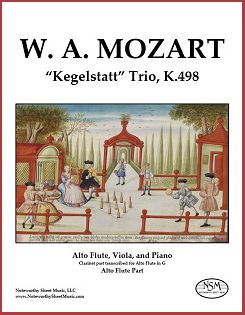 "Kegelstatt" Trio in E-flat major, K.498, by W. A. Mozart
"Kegelstatt" Trio in E-flat major, K.498, by W. A. Mozart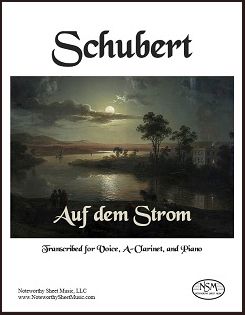 Auf dem Strom, Op.119, by Franz Schubert
Auf dem Strom, Op.119, by Franz Schubert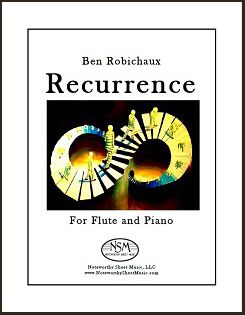 Recurrence, by Ben Robichaux
Recurrence, by Ben Robichaux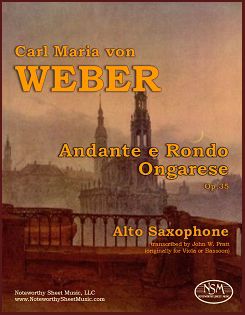 Andante e Rondo Ongarese, Op.35, by Carl Maria von Weber
Andante e Rondo Ongarese, Op.35, by Carl Maria von Weber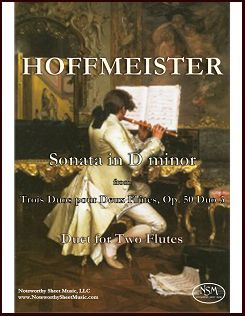 Sonata in D minor, Op.50, Duo 3, by Franz Anton Hoffmeister
Sonata in D minor, Op.50, Duo 3, by Franz Anton Hoffmeister Sonata in D Major, Op.5, No.1, by Giuseppe Maria Cambini
Sonata in D Major, Op.5, No.1, by Giuseppe Maria Cambini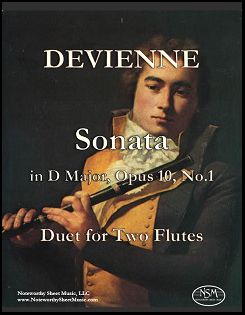 Sonata in D Major, Op.10, No.1, by François Devienne
Sonata in D Major, Op.10, No.1, by François Devienne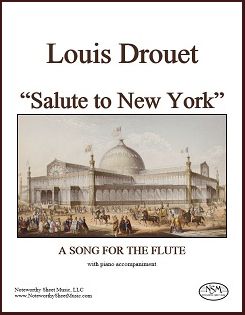 Salute to New York, A Song for the Flute, by Louis Drouet
Salute to New York, A Song for the Flute, by Louis Drouet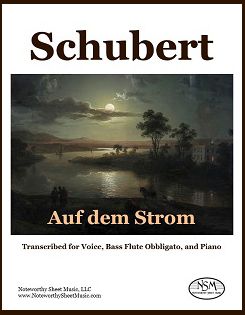 Auf dem Strom, Op.119, by Franz Schubert
Auf dem Strom, Op.119, by Franz Schubert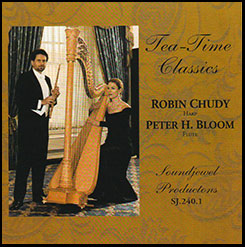 Tea-Time Classics
Tea-Time Classics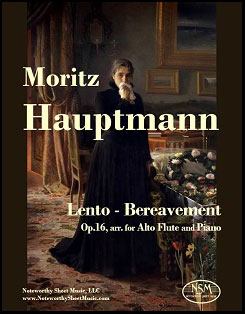 Lento - Bereavement, by Moritz Hauptmann
Lento - Bereavement, by Moritz Hauptmann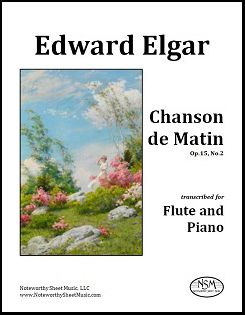 Chanson de Matin, Op.15, No.2, by Edward Elgar
Chanson de Matin, Op.15, No.2, by Edward Elgar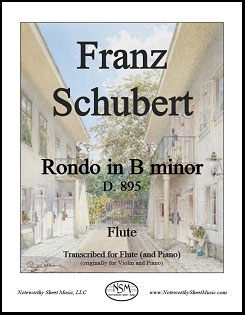 Rondo in B minor, D.895, by Franz Schubert
Rondo in B minor, D.895, by Franz Schubert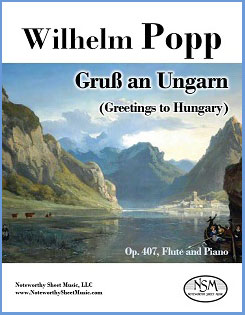 Greetings to Hungary, Op.407, by Wilhelm Popp
Greetings to Hungary, Op.407, by Wilhelm Popp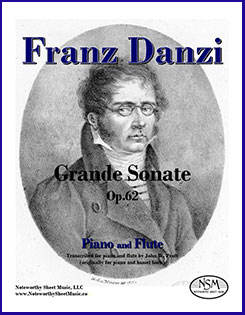 Grande Sonate, Op.62, by Franz Danzi
Grande Sonate, Op.62, by Franz Danzi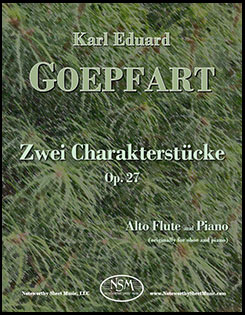 Zwei Charakterstücke, by Karl Eduard Goepfart
Zwei Charakterstücke, by Karl Eduard Goepfart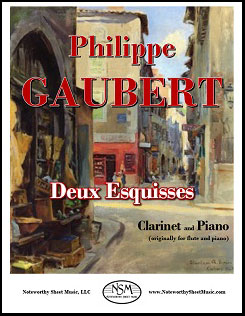 Deux Esquisses, by Philippe Gaubert
Deux Esquisses, by Philippe Gaubert Grande Sonate, by Franz Danzi
Grande Sonate, by Franz Danzi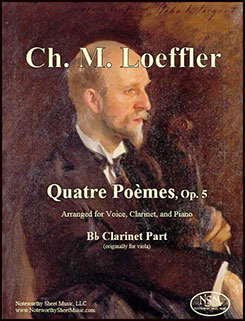 Quatre poèmes pour voix, alto et piano, by Charles Martin Loeffler
Quatre poèmes pour voix, alto et piano, by Charles Martin Loeffler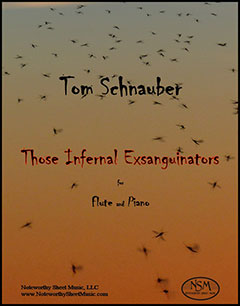 Those Infernal Exsanguinators, by Tom Schnauber
Those Infernal Exsanguinators, by Tom Schnauber